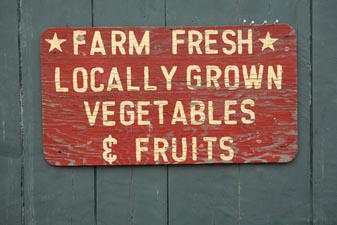Ask Natural Life...
Eating Sustainably - Which is Best:
Local or Imported Organic?
by Wendy Priesnitz
|

Photo © aastock/Shutterstock
|
Q: I live in a city and have been trying to eat organically for many years. In the summertime, I grow a small garden and frequent farmers’ markets because I enjoy buying from local farmers. I am happy that organics have become so popular that many of the natural food stores and even grocery stores are now selling organic fruits and vegetables year round. However, this spring, I was surprised to find these stores selling imported organic strawberries and asparagus when they were in season here! So my question is, which is better: locally grown produce that might not be organic or imported certified organic produce?
A: In an ideal world, you would be able to eat locally produced, certified organic food year round. However, in many climates that simply isn’t possible. And that’s when the decision to buy imported organic sometimes overrides the idea of eating locally. So the question becomes: Is a product that is certified organic but has racked up thousands of miles reaching your table still considered a sustainable food choice?
Organic food has been found to be more nutritious, in addition to being grown without polluting soil and water. Nevertheless, from a sustainability perspective, eating locally wins – no matter what the season. Food that must be transported long distances not only uses air polluting fossil fuels, but these foods also lose nutrition value on their journeys. In addition, some vitamins and antioxidants break down when exposed to air and light.
Researchers at two British universities recently published results of a study that found local food (grown within a 12-mile/20-km radius) to be more “green” than organic food. They calculated a shopping basket’s hidden costs, which mount up as produce is transported over long distances. They looked at factors like transportation-related damage to climate, infrastructure damage and the cost of transporting food on roads and by air. The problem can only be worse in North America, where the distances are greater. It has been calculated that most North American produce travels 1,500 to 2,500 miles to reach your supermarket, a huge environmental price to pay for eating grapes in winter, even if they’re organic.
You should also consider that the produce grown on small local farms and market gardens may have little or no chemical input, even if it doesn’t claim to be organic. Buying locally grown foods is one of the easiest and most direct ways to help small, diversified family farmers – who are struggling in the face of corporate agriculture – to survive.
So the choice is clear during your local growing season – buy local . But what do you do if you live in a northern climate where farmers can’t grow year round? Traditionally, people ate seasonally and stored hardy root vegetables for the winter. Buy or grow extra quantities of your favorite organic fruit or vegetable when it is in season and experiment with drying, canning, jamming or otherwise preserving it for a later date.
You could start to adjust your diet by eliminating just two or three of the farthest traveled out-of-season foods from your menus, waiting to enjoy them until they are available in-season from a local farmer.
Yes, you might have to give up fresh strawberries in January, but that is a small price to pay for sustainability. And you might make it up in taste. Champions of the growing “buy local” movement, many of whom are passionate about good, wholesome food, insist that the taste of fresh, locally grown carrots, for example, is far superior to carrots that have been hauled from another coast or continent.
For more information on this topic, please read my article Counting Our Food Miles.
Wendy Priesnitz is the Editor of Natural Life Magazine and a journalist with over 40 years of experience. She has also authored 13 books.
|

